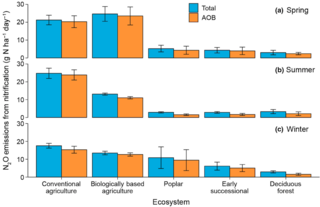Nitrification is a minor source of nitrous oxide in an agricultural landscape and declines with increasing management intensity
D. Liang and G.P. Robertson "Nitrification is a minor source of nitrous oxide (N2O) in an agricultural landscape and declines with increasing management intensity" Global Change Biology 27, 21 (2021) [DOI: 10.1111/gcb.15833]
The long-term contribution of nitrification to nitrous oxide (N2O) emissions from terrestrial ecosystems is poorly known and thus poorly constrained in biogeochemical models. Here, using Bayesian inference to couple 25 years of in situ N2O flux measurements with site-specific Michaelis–Menten kinetics of nitrification-derived N2O, we test the relative importance of nitrification-derived N2O across six cropped and unmanaged ecosystems along a management intensity gradient in the U.S. Midwest. We found that the maximum potential contribution from nitrification to in situ N2O fluxes was 13%–17% in a conventionally fertilized annual cropping system, 27%–42% in a low-input cover-cropped annual cropping system, and 52%–63% in perennial systems including a late successional deciduous forest. Actual values are likely to be <10% of these values because of low N2O yields in cultured nitrifiers (typically 0.04%–8% of NH3 oxidized) and competing sinks for available NH4+ in situ. Most nitrification-derived N2O was produced by ammonia-oxidizing bacteria rather than archaea, who appeared responsible for no more than 30% of nitrification-derived N2O production in all but one ecosystem. Although the proportion of nitrification-derived N2O production was lowest in annual cropping systems, these ecosystems nevertheless produced more nitrification-derived N2O (higher Vmax) than perennial and successional ecosystems. We conclude that nitrification is minor relative to other sources of N2O in all ecosystems examined.
KBS MCSE long-term field N2O flux measurements can be accessed here and long-term in situ soil NH4+-N concentrations are available here. Soil bulk densities of deep core soil samples are available here. Species composition of Early successional and Deciduous forest systems is available here and here. All other data are available at Dryad.
